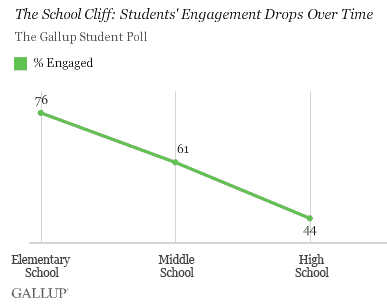"Education is the most powerful weapon which you can use to change the world." Nelson Mandela
 For years educators have been concerned with student engagement. Common sense and past experience tell us that the more interested, excited, and involved students are, the more likely they are to learn and retain what they are taught. Success in school correlates directly with student engagement.
For years educators have been concerned with student engagement. Common sense and past experience tell us that the more interested, excited, and involved students are, the more likely they are to learn and retain what they are taught. Success in school correlates directly with student engagement.
For several months, the term ‘fiscal cliff’ has been putting a terrifying face on the condition of our economic system. A recent survey/ blog from Gallup Polls identifies what they call the ‘school cliff.’ If you believe, as I do, that civilizations rise and fall according to how they educate their youth, this poll is enough to make you break out in a cold sweat.

Frightening, isn’t it? Out of almost a half-million students in grades 5-12, they found nearly eight in ten started out engaged and involved. By high school that number drops to only four in ten. Many of us have thought for years that our educational system needs revision, but this gives new impetus to the idea. The problem is, as always, where do you start?
The article mentions three probable causes of disengagement:
-
Overzealous focus on standardized testing and curricula
-
Lack of experiential and project-based learning for students
-
Few, if any, pathways for students who will not and do not want to go on to college
These reasons are valid, although a little daunting when looking for solutions. Legislation, local control, parent involvement, educational input, and financial conditions increase the difficulty of remedying the system. One more thing came to light when I read the original poll.
“84% of students who strongly agreed with [the statement],
‘My school is committed to building the strengths of each student,’
were engaged at school.”
Not only that, only 3% of the students who strongly agreed with this statement were deemed actively disengaged. The researchers found that schools that provided strength-based education had the highest rates of student engagement. They also noted two basic things strength-based schools did differently.
-
The schools assessed student strengths regularly and developed those strengths through formal programs.
-
They publicized the strength-development efforts to students, faculty, staff, parents, and the local community using everything from public service announcements to posters.
There are no simple solutions to this complex problem, but perhaps acknowledging student disengagement and seeking solutions is a starting point. What do you think? Where would you start to change things in education?
Smiles,
Kathy

-1.png)
